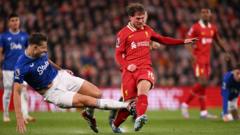It was a challenge that would not have looked out of place in a derby in years gone by - but even Everton manager David Moyes considered his captain James Tarkowski "lucky" to stay on the pitch.
In the 11th minute and with a loose ball to contest, Toffees centre-back Tarkowski lunged in to clear his lines but caught Liverpool midfielder Alexis Mac Allister just below the knee with his studs.
Referee Sam Barrott went immediately to his pocket and there could have been few complaints if he brandished a red card - but instead only a yellow was issued.
Within one TV replay it seemed clear the 32-year-old centre-half could yet find himself in trouble with the video assistant referee (VAR), but after a quick check - which lasted only 10 seconds according to the Premier League match centre - Paul Tierney decided no further action was necessary.
Commentating on the game for BBC Radio 5 Live, former Liverpool defender Stephen Warnock said: "Tarkowski knows exactly what he's doing in that situation. I think it is so dangerous. It is out of control from Tarkowski."
Reds boss Arne Slot later pointed out that "even people who are not liking Liverpool a lot are saying how clear and obvious it was", while Moyes added: "We could have been lucky we didn't get a red. It looked a high one."
Liverpool, though, edged closer to the Premier League title courtesy of Diogo Jota's winning goal - a strike itself not without controversy with Everton claiming for an offside in the build-up.
So what did the officials get right and wrong in another controversial Merseyside derby?
Was Tarkowski just 'reckless' or using 'excessive force'?
Explaining the decision, the Premier League Match Centre said on X: "The referee's call of yellow card for a reckless foul by Tarkowski was checked by the VAR, with contact on the follow through after Tarkowski had played the ball deemed to be reckless."
The key word here is "reckless", which according to law 12 merits a yellow card rather than a red.
However, Liverpool - and many onlookers - felt Tarkowski's challenge was not just reckless but also was made with excessive force.
According to law 12, as explained on the Football Association's website, "a tackle or challenge that endangers the safety of an opponent or uses excessive force or brutality must be sanctioned as serious foul play".
It continues: "Any player who lunges at an opponent in challenging for the ball from the front, from the side or from behind using one or both legs, with excessive force or endangers the safety of an opponent is guilty of serious foul play."
Taking this into account, Blues centre-back Tarkowski was somewhat fortunate to stay on the pitch, with his challenge leaving Mac Allister writhing in pain - though the Argentine World Cup winner was able to continue after receiving treatment.
It is also worth noting that, within the wording of the laws, there is no reference to winning the ball in making a tackle. If a player uses excessive force, whether he takes the ball or not is irrelevant - it would still meet the threshold for a red card.
When can VAR intervene - and why didn't it?
For such a robust challenge, it was a surprise that a VAR check and the subsequent decision came so quickly.
The Premier League rules state: "In the Premier League, there will be a high bar for VAR intervention on subjective decisions.
"The decision of the referee, known as the "referee's call", will stand unless, in the opinion of the ...



